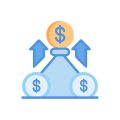Introduction: Shifting Trends in American Investing
The landscape of investing in the United States has changed dramatically over the past few decades. Once, individual stock picking was the go-to strategy for most Americans looking to grow their wealth. Today, however, more and more investors are turning toward pooled investment vehicles—specifically Exchange Traded Funds (ETFs) and mutual funds. This shift is not just a passing trend; it reflects a fundamental change in how Americans think about risk, diversification, and long-term growth.
Why Investors Are Moving Away from Stock Picking
In the past, investing often meant researching individual companies and building a portfolio one stock at a time. While this approach can be rewarding, it also requires significant time, knowledge, and risk tolerance. Many Americans found that keeping up with market news, analyzing financial statements, and timing trades was simply too demanding or risky.
Pooled Investments: The Modern Solution
ETFs and mutual funds offer an alternative by pooling money from many investors to buy a diversified set of assets. This allows individuals to access broad market exposure—even with small amounts of capital—while benefiting from professional management and reduced risk through diversification.
Key Differences: ETFs vs Mutual Funds
| Feature | ETF | Mutual Fund |
|---|---|---|
| Trading Method | Traded on exchanges like stocks throughout the day | Bought or sold only at end-of-day price (NAV) |
| Management Style | Often passively managed (tracks an index) | Can be actively or passively managed |
| Minimum Investment | No minimums; buy as little as one share | May require a minimum initial investment ($500-$3,000 common) |
| Fees | Generally lower expense ratios; trading commissions may apply | Slightly higher expense ratios; no trading commissions but other fees possible |
| Tax Efficiency | Tend to be more tax efficient due to structure | Less tax efficient; capital gains distributed annually |
The Appeal of Diversification and Simplicity
Pooled investments help everyday Americans avoid putting all their eggs in one basket. Instead of betting on a single company’s success or failure, investors own slices of hundreds—or even thousands—of companies at once. This approach helps reduce risk and makes investing accessible for people who may not have the time or desire to become stock market experts.
2. Understanding ETFs and Mutual Funds: Key Features and Differences
What Are ETFs and Mutual Funds?
Exchange-Traded Funds (ETFs) and mutual funds are two of the most popular ways for Americans to invest in the stock market. Both offer access to a diversified mix of stocks, bonds, or other assets, making them attractive to investors who want diversification without picking individual stocks. But their structure, trading methods, costs, and liquidity can be quite different.
Key Features at a Glance
| ETFs | Mutual Funds | |
|---|---|---|
| Structure | Traded on stock exchanges like shares; designed to track an index or sector | Pooled investment managed by professionals; priced at end of trading day |
| Liquidity | Bought and sold throughout the trading day at market price | Transactions processed after market close at net asset value (NAV) |
| Costs | Generally lower expense ratios; investors may pay brokerage commissions | Tend to have higher management fees; may include sales loads or redemption fees |
| Trading Mechanism | Bought/sold like stocks with real-time pricing; can use stop-loss or limit orders | Bought/sold through the fund company at end-of-day NAV; no intraday trading |
| Minimum Investment | No minimums—buy as little as one share | Often require minimum investments, sometimes $500 or more |
| Tax Efficiency | Generally more tax-efficient due to “in-kind” creation/redemption process | Less tax-efficient; capital gains distributed annually to shareholders |
Why Are These Products Attractive to American Investors?
Diversification Made Simple
Both ETFs and mutual funds allow investors to own a basket of securities, reducing risk compared to holding individual stocks. This is especially appealing for those who want exposure to the broader market or specific sectors without having to do extensive research on each company.
Easy Access and Flexibility
ETFs offer flexibility since they trade like stocks during market hours. This means you can buy or sell whenever the market is open, making them great for investors who value real-time pricing. Mutual funds, while less flexible in terms of trading, are simple for long-term investors who prefer not to watch the market daily.
Cost-Effective Investing Options
The low expense ratios of many ETFs attract cost-conscious investors. While mutual funds can be pricier, many employer-sponsored retirement plans (like 401(k)s) use mutual funds because of their professional management and convenience.
Straightforward Entry Points for All Budgets
You don’t need a lot of money to start investing in ETFs—just enough to buy a single share. Some mutual funds also have low minimums, but many require larger initial investments. This difference can make ETFs more accessible for beginners or younger investors starting with smaller amounts.
![]()
3. Market Growth: Historical Adoption and Current Trends
The American stock market has seen dramatic shifts in how investors put their money to work, especially with the rise of Exchange-Traded Funds (ETFs) and mutual funds. Over the past few decades, these investment vehicles have transformed from niche products into mainstream options for both everyday Americans and professional investors.
Key Milestones in the Growth of ETFs and Mutual Funds
Understanding when and how these funds took off helps explain why they are so popular today. Here’s a quick look at some major milestones:
| Year | Milestone | Description |
|---|---|---|
| 1924 | First Mutual Fund Launched | The Massachusetts Investors Trust marks the beginning of mutual fund investing in the U.S. |
| 1976 | First Index Mutual Fund Introduced | Vanguard launches the first index fund, making low-cost investing accessible to everyone. |
| 1993 | First U.S. ETF Debuts | The SPDR S&P 500 ETF (SPY) hits the market, offering real-time trading like a stock. |
| 2000s | ETF Explosion | Rapid growth as investors embrace ETFs for diversification, low fees, and flexibility. |
| 2019-2024 | Record-High Asset Flows | Booming demand pushes assets in ETFs and mutual funds to all-time highs. |
Adoption Trends: How Popular Are These Funds?
As more Americans focus on retirement savings and building wealth, mutual funds and ETFs have become household names. According to data from the Investment Company Institute (ICI):
- More than 100 million Americans invest through mutual funds or ETFs.
- Total net assets in U.S. mutual funds exceeded $23 trillion by early 2024.
- ETF assets surpassed $8 trillion in 2024, up from just $1 trillion in 2010.
- Younger investors are especially drawn to ETFs due to their transparency and ease of trading.
Main Reasons for Rapid Growth
- Low costs: Both ETFs and index mutual funds offer lower fees compared to traditional actively managed funds.
- Diversification: One fund can give exposure to hundreds or thousands of stocks and bonds.
- User-friendly platforms: Online brokers make it easy for anyone to start investing with small amounts.
- Transparency: Investors know exactly what they own, especially with ETFs that disclose holdings daily.
- Tax efficiency: ETFs are often more tax-efficient than traditional mutual funds, which appeals to long-term investors.
A Snapshot: Mutual Funds vs. ETFs Today
| Mutual Funds | ETFs | |
|---|---|---|
| Total Assets (2024) | $23+ Trillion | $8+ Trillion |
| No. of Products Available | Over 7,000 | Over 3,000 |
| Main Investors | 401(k), IRAs, Individual Investors | Younger Investors, Active Traders, Advisors |
This growth story shows no signs of slowing down as technology advances and investor preferences continue to evolve. For anyone looking to participate in the American stock market, understanding the history and current trends behind these investment options is now essential knowledge.
4. Drivers of Popularity: Why Americans Are Choosing Funds
Convenience and Accessibility
One of the biggest reasons behind the rise of ETFs and mutual funds in the American stock market is convenience. These investment vehicles make it easy for everyday people to access a wide range of stocks and bonds without needing to be experts or spend hours researching individual companies. With just a few clicks on an online brokerage platform, investors can buy shares in a fund that holds hundreds or even thousands of different assets.
Diversification Made Simple
Diversification is another key driver. Instead of putting all their eggs in one basket, Americans use funds to spread their investments across many sectors, industries, and even countries. This helps lower risk and gives peace of mind, especially during volatile market conditions.
Comparison: Diversification Benefits
| Investment Type | Diversification Level | Risk Reduction |
|---|---|---|
| Individual Stocks | Low | Low |
| ETFs/Mutual Funds | High | High |
Tax Efficiency Advantages
For many Americans, tax efficiency is a top concern. ETFs are often praised for their unique structure that can help minimize capital gains taxes, especially when compared to traditional mutual funds. This means investors may keep more of their returns over time.
Tax Efficiency Comparison Table
| Fund Type | Typical Tax Treatment | Main Advantage |
|---|---|---|
| ETFs | Generally more tax efficient due to in-kind transfers | Lower capital gains taxes for long-term investors |
| Mutual Funds | Capital gains distributed annually to shareholders | Simplicity for automatic investment plans (e.g., 401(k)) |
Sociocultural Shifts and Regulatory Support
The American financial landscape has also changed thanks to cultural shifts and regulatory updates. More people are taking charge of their retirement savings through employer-sponsored plans like 401(k)s, which often offer a menu of mutual funds and ETFs. Regulators have made investing safer and more transparent, giving Americans greater confidence to invest in funds rather than picking individual stocks.
5. Impacts on the U.S. Stock Market
How Indexed Investing Shapes Market Dynamics
Indexed investing, which is at the core of many ETFs and mutual funds, has dramatically changed how the American stock market operates. When investors put money into index funds, those funds automatically buy the stocks that make up a particular index—like the S&P 500—in proportion to their weights in the index. This approach means that money flowing into these funds leads directly to buying activity across a broad set of companies, regardless of each individual companys recent performance or outlook.
Effect on Trading Volume
The rise of ETFs and mutual funds has increased overall trading volume in the U.S. stock market. ETFs, in particular, are traded like stocks throughout the day, so every purchase and sale adds to trading activity. As more Americans use these products for their retirement accounts or general investing, daily volume on major exchanges has grown. The table below shows how fund flows can impact trading volume:
| Source | Trading Activity | Market Effect |
|---|---|---|
| Individual Investors | Direct stock trades | Stock-specific movement |
| Mutual Funds (Active) | Buy/sell based on fund manager decisions | Targeted stock impact |
| Index ETFs/Mutual Funds | Buy/sell all index components simultaneously | Broad market movement |
Influence on Stock Volatility
The large flows into and out of indexed products can affect how volatile individual stocks become. Since these funds often buy or sell stocks in bulk without considering company-specific news, some stocks may see price swings unrelated to their fundamentals. During periods when investors move large amounts of money into or out of ETFs and mutual funds—such as during market rallies or panics—stocks included in popular indexes can experience higher volatility.
Key Takeaways for Investors
- Bigger role for passive investing: Indexed products now drive a significant portion of daily trading and price changes in the U.S. stock market.
- Market moves may not reflect fundamentals: Sometimes, stock prices shift just because they are part of a widely held index, not because of news about the company itself.
- Diversification benefits: While individual stocks can be more volatile due to fund flows, investing through ETFs and mutual funds still spreads risk across many companies.
This new landscape means it’s important for both new and experienced investors to understand how big fund flows and indexed strategies can shape overall market behavior in America.
6. Considerations for Investors: Navigating the Choices
Understanding Your Investment Goals
Before deciding between ETFs and mutual funds, it’s important to identify your financial goals. Are you investing for retirement, saving for a major purchase, or looking to grow your wealth over time? Your answers will help determine which investment vehicles are best suited to your needs.
Key Differences Between ETFs and Mutual Funds
| Feature | ETFs | Mutual Funds |
|---|---|---|
| Trading Flexibility | Buy/sell throughout the trading day at market price | Bought/sold at end-of-day NAV (Net Asset Value) |
| Minimum Investment | No minimums (just price of one share) | Often have minimum investment requirements (e.g., $1,000) |
| Fees/Expenses | Typically lower expense ratios; may pay brokerage fees | Slightly higher expense ratios; no trading commissions but possible sales loads |
| Tax Efficiency | Generally more tax-efficient due to “in-kind” transfers | May distribute capital gains annually, leading to potential tax liabilities |
| Automatic Investing/Reinvestment | Not always available automatically through brokers | Easy automatic investment and dividend reinvestment options |
Practical Tips for U.S. Investors
Diversify Your Portfolio by Combining Both Options
You don’t have to choose just one. Many American investors combine ETFs and mutual funds to create a well-rounded portfolio. For example, you might use low-cost index ETFs for broad market exposure and add actively managed mutual funds to target specific sectors or strategies.
Consider Costs and Accessibility
If you’re just starting out or want to invest small amounts regularly, mutual funds with low minimums or commission-free ETFs might be ideal. Always compare expense ratios—over time, even small differences can impact your returns.
Evaluate Trading Preferences and Convenience
If you prefer real-time trading and want more control over pricing, ETFs offer flexibility. If you value automation, set-it-and-forget-it investing, or want systematic monthly contributions, mutual funds typically make this easier.
Assess Tax Implications for Your Account Type
If you’re investing in a taxable account, favoring ETFs could help minimize unwanted capital gains distributions. In tax-advantaged accounts like IRAs or 401(k)s, tax efficiency is less critical—so focus on performance and fees instead.
Sample Portfolio Mix for American Investors:
| Asset Class/Goal | ETF Example | Mutual Fund Example |
|---|---|---|
| Total U.S. Stock Market Exposure | Vanguard Total Stock Market ETF (VTI) | Fidelity® Total Market Index Fund (FSKAX) |
| Bonds for Income & Stability | iShares Core U.S. Aggregate Bond ETF (AGG) | PIMCO Total Return Fund (PTTRX) |
| Diversification: International Stocks | iShares MSCI ACWI ex U.S. ETF (ACWX) | T. Rowe Price International Stock Fund (PRITX) |
| Tactical Sector Allocation* | Select Sector SPDR ETFs (e.g., XLV for Health Care) | T. Rowe Price Health Sciences Fund (PRHSX) |
*For investors seeking targeted sector exposure alongside core holdings.
The Bottom Line: Match Tools to Your Needs
Your ideal mix of ETFs and mutual funds will depend on your goals, preferences, and investment timeline. By understanding the unique benefits of each—and thoughtfully combining them—you can build a resilient portfolio that helps you stay on track toward your financial aspirations in the ever-evolving American stock market.


